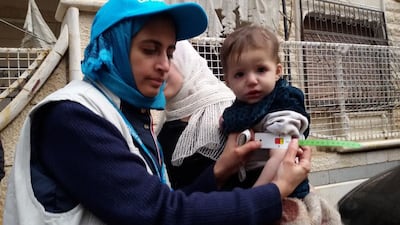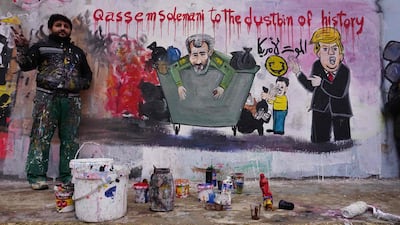The voice on the other end of the line sounded like nothing I had heard before. There was a gasping, exhausted weakness to it, as though the young man whose voice it was had put every ounce of energy he had left into articulating the words. It was the voice of somebody who was being starved to death.
The young man was a resident of Madaya, a town of about 40,000 people near the Syrian-Lebanese border. It was January 2016 and for months, the townsfolk had been living under a tight starvation siege that had reduced them to eating leaves, grass, and water flavored with spices to stave off their extreme hunger.
The men who imposed the siege belonged to Hezbollah, Iran's most powerful proxy. Along with other Tehran-backed militias, overseen by Qassem Suleimani, they pursued scorched-earth tactics, brutal starvation sieges and naked sectarianism in their campaign to save the totalitarian regime of Bashar Al Assad as it fought for survival against a popular uprising.
The shock killing of Suleimani in an American airstrike near Baghdad airport over the weekend has left the Middle East in turmoil and apprehension. The instability, conflicts and battle for influence, and the violence that has plagued the region for most of the past two decades has been exacerbated by a sense of deep uncertainty about what comes next. No matter how it all unfolds, we can be sure that ordinary civilians in the Arab world and Iran will bear the brunt of it all.
But in Syria, ravaged by nine years of war, Suleimani’s legacy endures. It is a legacy of brutal and inhumane warfare, displacement on an unprecedented scale, and rampant sectarianism. His victims in Syria are forever scarred by the tyranny he helped impose.
Iran's intervention in Syria began early in the course of the conflict, even as the Assad regime teetered in 2012. The first major campaign involving Hezbollah took place in 2013, with the siege of Qusayr, a border town and rebel stronghold not far from Homs. In addition to providing a financial lifeline to Mr Al Assad, Iranian advisers led by Suleimani drew upon their network of regional proxy forces and militias to fight for the Syrian regime, helping transform the conflict into one with an overt sectarian nature.
Syria was crucial to Iran’s campaign to build an influence network throughout the region, maintaining a land route stretching from its territory through to the Mediterranean and supply routes for Hezbollah in Lebanon. Over the following years, Suleimani would work to crush the popular uprising, determined to keep the strategic upper hand for Iran in the face of a popular revolt.
In addition to Hezbollah, Iraqi Shiite militias also joined the battle. Suleimani often appeared on the frontlines to oversee military offensives, and militia leaders and commanders frequently used sectarian language to strengthen the resolve of their fighters. He helped oversee the reorganisation of pro-Assad Syrian forces into so-called national defence militias, many of them overtly sectarian in their identity, weakening in the process the central state. Suleimani’s apparatus recruited hundreds of Pakistani and Afghan refugees, drafting them into ground troops fighting endless battles against rebels in Aleppo and elsewhere, in exchange for promises of proper residency status in Iran and a regular income.
Suleimani was also crucial in securing Russian intervention in the war in late 2015, at a particularly vulnerable moment for Mr Al Assad, reportedly travelling to Moscow to personally brief Russian leaders on the conflict. Their involvement would turn the tide while ushering in a period of unprecedented violence in the conflict and spiraling civilian casualties as Mr Al Assad advanced and reclaimed rebel-held ground.

But perhaps the cruelest demonstration of that legacy is in the inhumanity with which Suleimani’s proxy forces prosecuted the war. The siege of Madaya was replicated in other parts of the country, with Iranian-backed militias including Hezbollah participating in sieges throughout the country, including in Homs and the suburbs of Damascus and Aleppo. During negotiations for the surrender of rebel fighters in east Aleppo, one Turkish official with knowledge of the talks, which involved Ankara and Moscow, told me that while the Russians were keen on negotiating a deal, the “Iranians just want to raze Aleppo to the ground".
Pro-Iranian militias were accused of a range of abuses against civilians as they spearheaded major ground assaults by pro-Assad forces, including extrajudicial killings. The scorched-earth bombardment and inhumane siege conditions gave way to negotiated surrender deals in which civilians were forcibly displaced from their homes for daring to protest Mr Al Assad’s totalitarian state. As a result, Suleimani’s proxies were instrumental in a broad campaign of demographic engineering that inflamed sectarian tensions and led to the dispossession and displacement of tens of thousands of Syrian civilians.
The destruction that Suleimani and his underlings wrought in Syria will take years to unpack. At its heart, though, was a cruel calculus that saw the infliction of grave suffering and war crimes on civilians, who simply wanted to live in dignity, as an acceptable means to an expansionist, hegemonic end.
In Syria, Suleimani’s main legacy is saving the tyrant.
Kareem Shaheen is a former Middle East correspondent based in Canada


